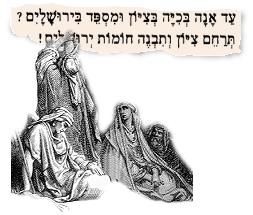|


The first nine days of Av are a sorrowful period culminating with Tish'ah
be-Av, the Ninth of Av. Tish'ah be-Av is the most intensive day of mourning
for the destruction of the Temple and the exile, and the only fast apart
from Yom Kippur that lasts from sunset to the following evening. According
to the sources, both the First and the Second Temples were destroyed
on this date (in 586 BCE and 70 CE respectively).
 Betar,
the last fortress to hold out against the Romans in the Bar Kokhba revolt, fell
on the ninth of Av in the year 135 CE. There is also a tradition that it was
on this date that the generation of Israelites who had left Egypt were told
by God that they would not enter the Promised Land. Over the course of Jewish
history, other communal and national calamities were ascribed to this sad day,
one of the most prominent being the expulsion from Spain in 1492. Betar,
the last fortress to hold out against the Romans in the Bar Kokhba revolt, fell
on the ninth of Av in the year 135 CE. There is also a tradition that it was
on this date that the generation of Israelites who had left Egypt were told
by God that they would not enter the Promised Land. Over the course of Jewish
history, other communal and national calamities were ascribed to this sad day,
one of the most prominent being the expulsion from Spain in 1492.
The liturgy of Tish'ah be-Av includes the mournful chanting of the Book of Lamentations,
which describes the horror of the fall of Jerusalem and a number of medieval
dirges (kinot). It is customary to echo the sense of devastation by sitting
on the floor while reading these texts by candlelight.
The Sabbath before the Ninth of Av was at one time referred to as the Sabbath
of Punishment and later as the Sabbath of Vision (Shabbat Hazon, from
the opening words of the prophetic portion from the Book of Isaiah read on this
Shabbat). It became customary not to eat meat or drink wine during these nine
days (except for Shabbat).
AV
Table of Contents
|